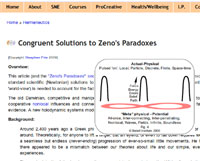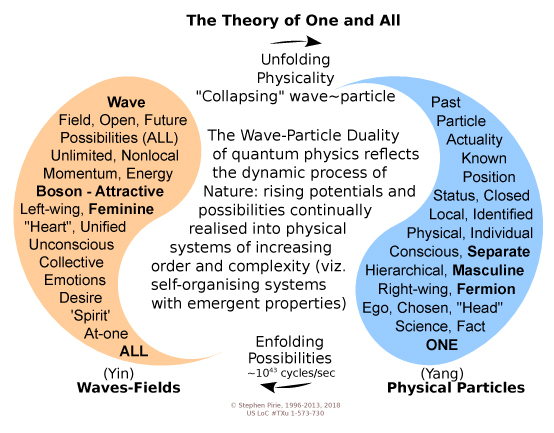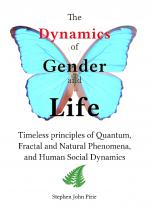This proof (in addition to others1) shows that physical movement is impossible, when it is theoretically based on standard2 scientific assumptions. Since everyday physical movement is not only possible but routinely lived and experienced, we can confidently conclude that modern scientific world-views are "wrong" (in that they do not fully account for, or explain the facts).
The objective of these proofs is to reveal how our modern scientific views are surface-layer perceptions that do not reveal or account for deeper, nonlocal (meta-physical) rhythms and processes.
- Scientific Assumption #1: The standard, widely-accepted scientific solution for explaining the paradox of physical movement (often referred to as Zeno's Paradoxes) is fully resolved by the mathematics of infinite series. In particular, the assumption of, and reliance on a one-to-one correspondence of mathematical points with physical points is required. It is never assumed or stated that the mathematical points (in whichever equations or formula) are entirely unrelated to physical reality: that would make the mathematical expressions a 'nonsense' exercise. The assumption is that we are able to traverse each point in an infinite sequence of 'infinitesimal' contiguous physical steps in finite time, thus enabling everyday movement of our bodies etc.
- According to experiment evidence, objects (such as atoms, molecules -- and thus people3) behave in a wave-like manner, with the de Broglie wavelength λ of the object given by the formula λ=h/p, where h = Planck's Constant, and p = momentum of the object. In other words, the momentum of a moving object is equal to Planck's Contant divided by the de Broglie wavelength.
- The infinitesimal movement of the object (as required by infinite-series solutions as per Assumption #1) requires that λ approaches zero (since the de Broglie wavelength of the object indicates the range of possible positions and momenta of the object, and for definitive correlation of its position and momentum with that of some mathematical expression, the wavelength needs to be an "infinitisemally short pulse" to ensure precise locality, physicality and momentum). However, when the wavelength approaches zero -- as required by Assumption #1, and since p=h/λ -- the momentum gets divided by near zero, sending it towards infinity. This is an unavoidable consequence of infinite-series solutions to Zeno's Paradoxes, since they are reliant on a strict and absolute one-to-one correspondence between some arbitrary mathematical point, and its corresponding physical location and momentum.
- Thus for an object to physically move to and exist at each and every infinitesimal point along its path, requires the object to have infinite mass, and/or infinite velocity.4
- As a result, to move an object (such a finger) through some arbitrarily small infinitesimal movement, requires that it gain infinite momentum which in turn would require infinite energy, thus making physical movement an impossibility.
What does all this imply?
 Simply put, (and as was simply explained over 40 years ago by the world-renowned physicist Richard Feynman):
Simply put, (and as was simply explained over 40 years ago by the world-renowned physicist Richard Feynman):
"the idea ... that space is continuous is, I believe, wrong."5
Our whole space-time is, in effect, continually 'blinking on and off' at a very very fast rate (so physical movement appears continuous, and things always appear to be 'just here').
Accordingly the mathematics of infinite series applies only in part to our physical space-time, and also to deeper nonlocal and nonphysical dimensions. "Infinite-series" simply "map" the infinite superpositions underlying our finite-positioned reality. This explains the ability of the mathematical expressions to 'fit' our world, while also pointing to deeper processes that remain beyond tangible physicality.

See also:
- The Real Scandal of Quantum Mechanics (Prof. Richard Conn Henry, The Johns Hopkins University)
- The Mental Universe (Prof. Richard Conn Henry, The Johns Hopkins University)
- A Clearer Light (Prof. Richard Conn Henry)
- 1. See in particular "Proof of the impossibility of physical movement"
- 2. "standard scientific assumptions" are that we live in an mechanical, deterministic universe. And that all physical effects can be assigned to some identifiable physical cause. Unfortunatelly that world-view simply cannot explain the facts -- as is easily demonstrated by a number of throught-experiments, including the 1st and 2nd proofs of the impossibility of physical movement.
- 3. It is argued that objects the weight (mass) of people would have an imperceptibly small wavelength. But when movement of fingers, arms and people involves infinitesimal increments, as required by Assumption no. 1, the wavelength, despite being imperceptibly short, must go infinitely shorter, thus requiring mass and/or momentum to become infinite. In other words, according to standard scientific world-views, movement is theoretically impossible.
- 4. Since p = h/λ, when λ approaches zero, p approaches infinity.
- 5. — Professor Richard Feynman, The Messenger Series: Seeking New Laws
 "The Dynamics of Gender and Life" ebook is now available at
"The Dynamics of Gender and Life" ebook is now available at